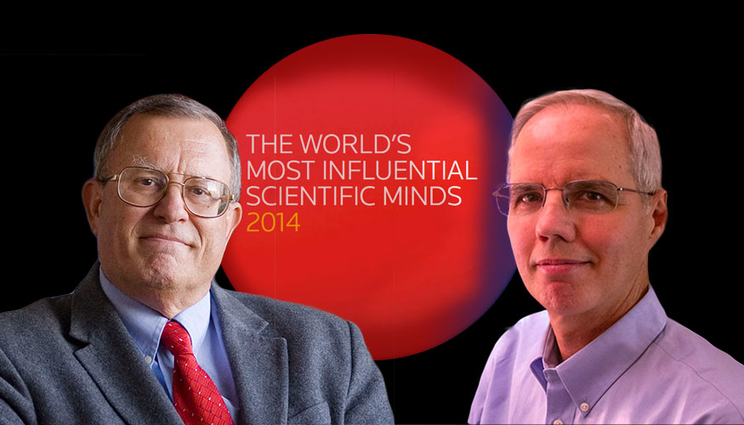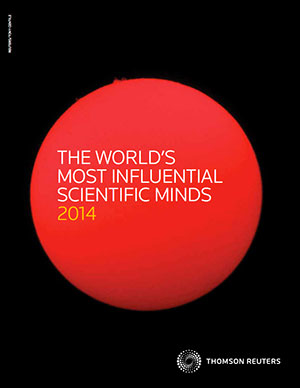Scientists burst onto influential list for combustion research
Lawrence Livermore scientists Charles Westbrook and William Pitzhave been named to Thomson Reuters list of "The World's Most Influential Scientific Minds."
Westbrook and Pitz are part of the 3,000 researchers who were identified by analyzing citation data over the last 11 years to recognize those who published the highest-impact work (2002-2012 and 2012-2013). The two were selected from their numerous research papers on combustion modeling.
"This recognition is a great honor for Charlie Westbrook and Bill Pitz and extremely well deserved," LLNL Director Bill Goldstein said. "It also is indicative of the bright minds working together at Lawrence Livermore to solve some of the nation's most challenging problems."
Westbrook and Pitz produced a chemical kinetic study of fuel additives for engine knock in spark ignition engines, a feat that earned them the 1991 Horning Award from the Society of Automotive Engineers (SAE).
Their area of research is to develop chemical kinetic mechanisms for conventional fuels like gasoline and diesel fuel, and also for next-generation fuels, such as new types of biofuels being considered as potential replacements for fossil fuels.
The chemical kinetic mechanism of Westbrook and Pitz are used in computer codes to simulate combustion in internal combustion engines used in cars and trucks. These engine simulation codes can be used to optimize engine design to increase efficiency and reduce pollutant emissions. Pitz said what interests them the most is enabling the simulation of advanced combustion engines being considered for future vehicles, because these engines offer prospects of gains in efficiency and reductions in emissions.
"It is gratifying for both Charlie and me to be recognized for work that has been the focus of our careers," Pitz said.
Charles Westbrook
Westbrook is LLNL's combustion guru - a pioneer in the combustion field for more than 35 years. While he officially retired from the Laboratory in 2005 (after 41 years of service), he can still be found at the Lab a few days a week working on chemical kinetic modeling codes, the backbone of combustion.
He realized early on his career that the same codes he was working on to study the dynamics of weapons also could be applied to combustion chemistry. By grasping this, Westbrook was on his way to becoming the combustion leader at the Lab, in the auto industry and worldwide.
"One factor for our high publication rate is that we build chemistry models that can be used to interpret experiments and help design internal combustion engines for a rather wide variety of fuels, from gasoline to diesel fuel to ethanol to biodiesel fuel," Westbrook said. "The real key is that, along with the papers describing those models, we put the actual model software, called a chemical kinetic reaction mechanism, onto the LLNL open website, and this has turned out to attract an enormous number of other researchers who want to use our reaction mechanisms in their own work."
Westbrook has won many awards for his research, including fellow of the Society of Automotive Engineers (SAE), the Combustion Institute's 2008 Bernard Lewis Gold Medal, the American Chemical Society's Thomas Midgley Award, SAE's Horning Memorial Award, SAE's Arch Colwell Award of Merit in 2000 and 2003, Wilhelm Jost Memorial Lectureship at Deutsche Bunsengesellschaft far Physikalische Chemie/Akademie der Wissenschaften zu Gattingen and Docteur Honoris Causa from the Institute National Polytechnique de Lorraine. In addition, he was president of the Combustion Institute from 2008-2012.
William Pitz
LLNL engineer Pitz' research focuses ondevelopment of chemical kinetic mechanisms for hydrocarbon fuels, oxygenated fuels and oil-sand derived fuel and applying these mechanisms to problems such as combustion in homogeneous charge compression ignition (HCCI) engines and diesel engines.
He earned his bachelor's and master's degrees in engineering from Purdue University and his Ph.D. in mechanical engineering from the University of California, Berkeley, where he did his thesis work in the combustion area.
After accepting a postdoc position at LLNL working for Westbrook in the area of developing chemical kinetic models for hydrocarbon fuels, he has continued his career at Livermore in the same field.
The Thompson Reuters list highlights some of the standout researchers from the past decade, from a compilation of 3,000 of the most influential authors in 21 fields of science or social science. These researchers earned this distinction by writing the greatest numbers of reports officially designated by essential science indicators as highly cited papers.
The authors on the World's Most Influential Scientific Minds list rank among the top 1 percent most cited for their subject field between 2002 and 2012. The listings of highly cited researchers feature authors whose published work in their specialty areas has consistently been judged by peers to be of particular significance and utility.
Contact
 Anne M. Stark
Anne M. Stark
[email protected]
(925) 422-9799
Related Links
The World's Most Influential Scientific MindsIdeas that fire on all cylinders
Combustion Chemistry
Kinetic Models Predict Biofuel Efficiency
The internal Combustion Engine at Work
Tags
Physical and Life SciencesFeatured Articles









